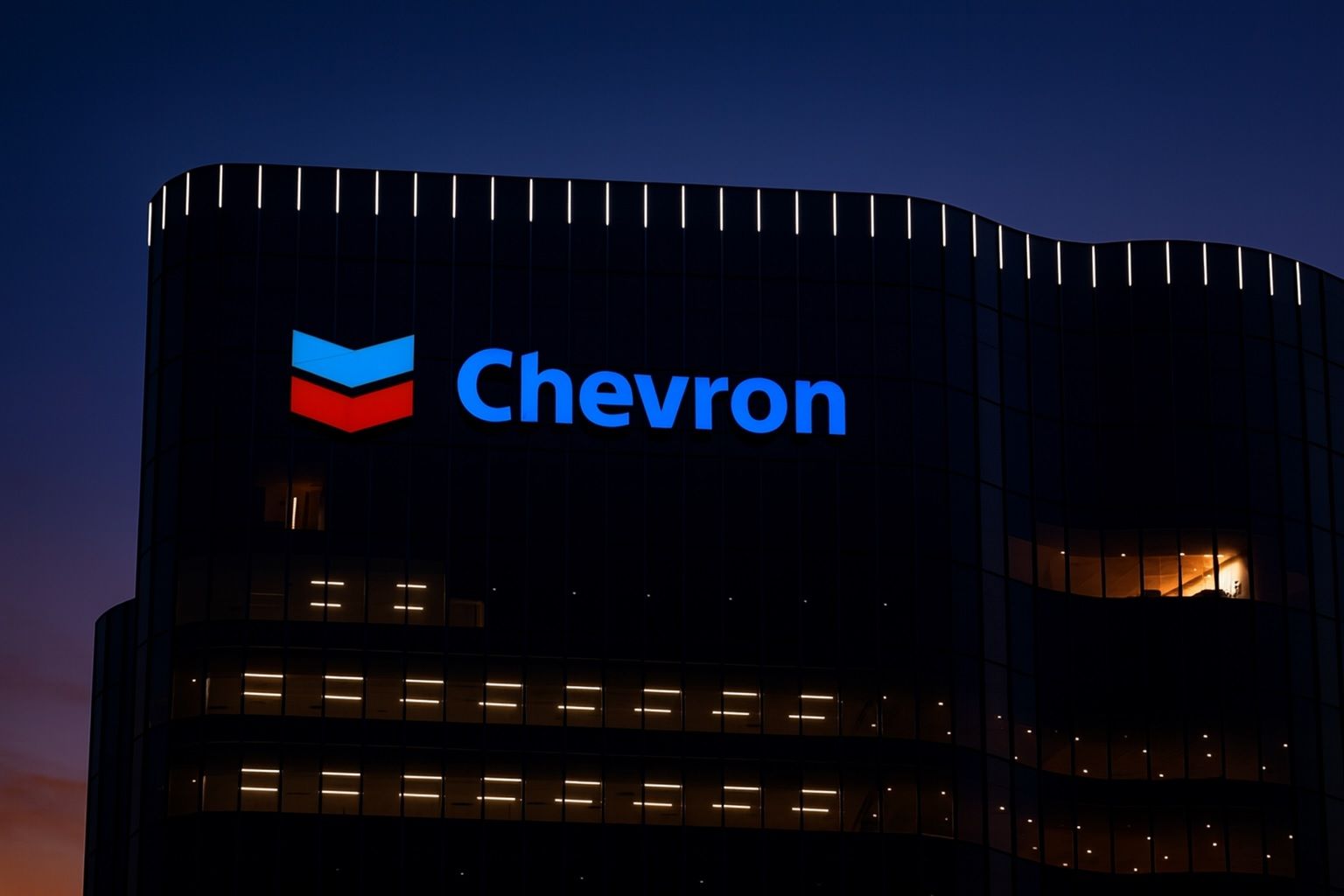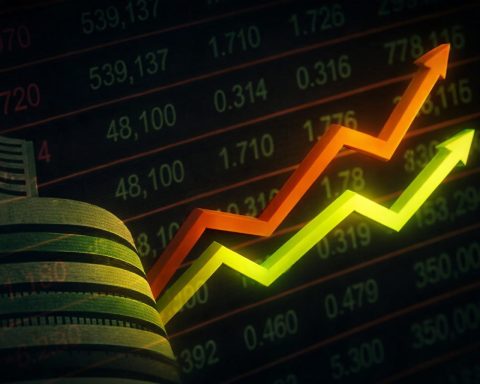- Current Price & Recent Moves: Chevron closed at about $153 on Oct 17, 2025 [1]. The stock has mostly traded in the $150–154 range over the past week [2], little changed on balance despite oil price swings.
- Major News: Chevron agreed to sell Denver-Julesburg (DJ) Basin pipeline assets for over $2 billion [3], and it completed the Hess acquisition in July (boosting reserves). An October 2–3 refinery fire in El Segundo (LA) was extinguished with no injuries [4]. New VP of Exploration Kevin McLachlan starts Nov. 1 [5].
- Earnings & Cash Flow: In Q2 2025 Chevron earned $1.45/share (net) vs $2.43 a year ago [6]. Adjusted EPS was $1.77 (down from $2.55) as weaker oil prices and merger costs offset record output. The company returned $5.5 billion to shareholders in Q2 (13th straight quarter >$5 billion) [7]. UBS projects Q3 EPS ~$1.65 (vs $1.77 in Q2) due to the Hess deal diluting per-share results [8].
- Oil Market Context: Global oil supply is rising faster than demand, with OPEC+ pumping aggressively. The IEA warns of a 4 million-barrel-per-day surplus in 2026 [9]. Oil prices eased to roughly $62–64/barrel Brent by mid-Oct [10] [11]. This oversupply pressure caps earnings for Chevron and peers.
- Analyst Views: Wall Street leans bullish overall: 16 analysts rate CVX a “Buy” (average target ~$170) [12]. UBS reiterated a Buy with a $197 target [13], and Wells Fargo just initiated Overweight (Buy) at $190 [14]. Raymond James remains Outperform but trimmed its target to $160 [15]. Scotiabank raised its target to $165 (Sector Perform/Hold) [16]. Chevron’s dividend yield is about 4.5% [17], among the highest in big oil.
- Fundamentals & Outlook: Fundamental models favor CVX – a recent ts2.tech (Validea) analysis scored Chevron 93% on a Peter Lynch P/E-growth screen, with strong margins and a clean balance sheet [18]. Management is cutting costs (up to 20% workforce reduction announced) and divesting non-core assets [19]. Growth drivers include Guyana production, Eastern Med gas, and low-carbon projects. Still, Chevron faces headwinds from oil market volatility and future energy transition trends.
Current Stock Performance
Chevron’s stock (NYSE: CVX) has been relatively flat in recent days. After closing around $152–153 last week [20], CVX closed at $153.08 on Oct 17 (up ~0.9% that day) [21]. This puts it roughly in the middle of its 5-day range ($150–154) [22]. Year-to-date CVX has lagged some competitors, reflecting weaker oil prices and the cost of merging Hess. For context, the broad S&P 500 is near all-time highs, while energy stocks are under pressure. Still, technical indicators (e.g. moving averages) suggest Chevron is holding important support in the mid-$140s.
Recent Price Moves: Oil markets have swung this month. After dipping below $60 in September, Brent has modestly rebounded. Chevron’s stock mirrored crude: it fell from ~$158 in mid-September to ~$147 by early Oct, then recovered toward $153 by Oct 17 (as oil held around $62–64) [23]. Trading volume was moderate (~7.7M shares on Oct 17) [24], and CVX’s volatility is near its multi-year lows, in line with the subdued energy market.
Major Company Developments
1. Hess Merger & Production
Chevron closed its $55 billion acquisition of Hess Corp in July 2025, adding major offshore oil projects (e.g. Guyana) to its portfolio [25] [26]. This deal boosts Chevron’s reserves and future output, but it also weighed on near-term earnings. In Q2 2025 (the first full quarter post-deal), Chevron reported $2.5 billion net income ($1.45/share), down from $4.4B a year earlier [27]. Adjusted for one-time items, Q2 EPS was $1.77 (vs $2.55) [28]. CEO Mike Wirth noted the quarter saw “record production” (the Permian averaged ~1 million barrels of oil equivalent per day [29]) and “exceptional cash generation.” However, Hess share valuations and FX pressures cut GAAP profit.
Looking ahead, analysts expect energy prices will remain sub-$70. UBS forecasts Chevron’s Q3 EPS around $1.65 (flat to slightly down sequentially) [30]. Management is focused on cost synergy targets with Hess (e.g. cutting redundant staff and overhead) and ramping up high-return projects. The company reiterated that Hess integration is on track and will boost volumes, but Q3 may still show earnings dip versus Q2 due to realized product margins. An upcoming Investor Day (Nov 12) is slated to provide more long-term guidance on growth, capital spending, and returns.
2. Pipeline & Asset Sales
To streamline operations, Chevron is selling non-core midstream assets. In October, Reuters reported Chevron plans to divest pipeline systems in Colorado’s DJ Basin for >$2 billion [31]. These assets (originating from the acquired Noble Energy assets) generated roughly $200M EBITDA. The deal is expected to close by late 2025 and free up capital. Wirth has said Chevron will “challenge itself to divest assets that take money away from more profitable prospects” [32]. Overall, Chevron is cutting roughly 20% of its workforce and shedding poor-return businesses to bolster its financial profile [33].
Dividend & Buybacks: Chevron continues to reward shareholders. In Q2 it returned $5.5 billion via dividends and share repurchases [34] (13 consecutive quarters above $5B). The quarterly dividend of $1.71 (from Aug 2025) implies a 4.5%+ yield [35], one of the highest among large oil companies. This hefty yield and cash flow give investors a cushion if oil prices stay subdued.
3. Refinery Fire – Resolved
In early October, a major fire erupted in Chevron’s El Segundo (Los Angeles-area) refinery’s jet fuel unit (see Reuters) [36]. The blaze, which began Oct 2, led Chevron to shut several units (hydrocracker, reformer, cracker), potentially disrupting California fuel supply. Importantly, there were no injuries and all workers were safe [37]. Chevron stated by Oct 3 that “the fire had been put out” [38] and investigation had begun. The refinery (second-largest in CA, 285K bpd) remains offline or in partial repair mode for now. Fuel analysts warn this could raise California prices modestly in the near term, but there’s ample import capability. Oil traders marked up U.S. jet fuel prices by ~33¢/gal on the news [39]. For Chevron, the incident is a near-term earnings headwind (lost production + restart costs) but no long-term damage.
4. Management Changes
Chevron named Kevin McLachlan as VP of Exploration (effective Nov 1), succeeding Liz Schwarze who retires after 36 years [40]. McLachlan (ex-TotalEnergies, Murphy, Exxon) will oversee all global exploration. His hire underscores Chevron’s push into new resources (Guyana, Eastern Med, carbon sequestration). This comes amid some shareholders’ frustration that recent exploration results (e.g. Namibia, Suriname) haven’t met expectations. McLachlan’s experience in finding offshore oil may help revitalize Chevron’s upstream growth.
Energy Market & Geopolitics
Global oil dynamics are cooling. The International Energy Agency (IEA)’s Oct 2025 report highlights that OPEC+ dramatically raised output in September (up 1 mbpd) [41], keeping supply well ahead of demand. The IEA now expects a 4 mbpd surplus in 2026 [42]. Moscow and Riyadh are unwinding cuts faster than planned, pushing prices down. By mid-Oct, Brent crude traded in the low-$60s (around $62/bbl) [43], near a multi-month low.
Geopolitical news is mixed. Russia and Iran face fresh sanctions, but they’ve managed to maintain output so far. Tensions in Ukraine and the Middle East remain geopolitical wildcards; any disruption there could sharply raise prices. Conversely, demand growth is slowing amid global economic headwinds and the energy transition. The IEA trimmed its demand outlook (700 kbpd growth in 2025) [44], reflecting electric vehicle uptake and weaker industrial demand in China/Europe.
Refinery capacity shifts also matter: California is losing refining capacity, with Phillips 66 closing its L.A. plant and Valero’s Benicia refinery slated to shut in 2026 [45]. This tightens West Coast supply (highlighted by the El Segundo fire). In short, oil is likely to trade in a wide range ($50–80) over the next year. For Chevron, higher oil benefits its upstream earnings; lower oil squeezes margins but is partly offset by its integrated business (refining chemicals) and capital discipline.
Earnings Trends & Forecasts
Chevron’s recent earnings showed the tension between strong operations and a weak price environment. Q2 2025 revenue from Upstream fell (U.S. and Int’l earnings both down on lower selling prices). In downstream (refining/chemicals), earnings held up well ($737M vs $597M a year prior) [46], helped by high fuel margins (before the fire). Cash flow remained robust: operating cash was $8.6B in Q2 [47]. Management maintained full-year guidance: around 1.8 MMBbl/day global oil output (including Hess) and $21–23B capital spend.
Analysts note that Chevron’s Q4 2025 and 2026 estimates may be driven by project ramp-ups (Guyana FPSOs, LNG train in Qatar) and cost cuts. For example, UBS and others expect volumes to rise late next year, which could underpin higher profits even if price stays low. Conversely, any further oil-price slide would hit results. Several banks point out Chevron’s strong balance sheet and capital returns as bulwarks: even at $60 oil, Chevron should maintain its dividend and continue buybacks thanks to its integrated operations and debt discipline.
Analyst Ratings & Expert Commentary
Wall Street is generally optimistic on Chevron’s long-term value. As of mid-Oct 2025, consensus is “Buy” (or Overweight) across major firms [48]. The average 12-month price target is about $170 [49] (implying ~10% upside from $154), with the high end near $197 (UBS) and low end around $124 (some newer bear/higher-growth views) [50].
Key analyst notes:
- UBS (Josh Silverstein): Reaffirmed Buy, $197 target (Oct 13) [51]. UBS highlights Hess synergies, cost cuts, and expanding Permian output as upside. They note Q3 EPS may dip (to ~$1.65) but expect an upbeat Investor Day.
- Wells Fargo (J. Margolin): Initiated Overweight with $190 target (Oct 17) [52]. Wells Fargo argues that broad bearishness on oil creates stock-picking opportunities. It points to Chevron’s strong cash returns and projects it will lead in dividend growth across scenarios (China growth to India demand mix).
- Raymond James (J. Jenkins): Keeps Outperform rating but lowered target to $160 (from $170) on Oct 17 [53]. Despite trimming the target 6%, RJ maintains confidence in Chevron’s assets and balance sheet. The firm says near-term margins are weaker, but Chevron’s long-cycle projects (Guyana, Med) have industry-leading returns.
- Scotiabank: Raised target to $165 (from $160), Sector Perform (Hold) on Oct 9 [54]. Scotiabank upgrades estimates marginally but cautions that improved margins have fallen short of earlier industry forecasts. It sees Chevron fairly valued given risks.
- Barclays/Mizuho/others: Generally hold or moderate buy with targets $158–192. Barclays trimmed to $158 [55], citing a softer outlook, while Mizuho reiterated Buy at $191 (Sep).
In sum, favorable catalysts (Hess volumes, cost cuts) underpin bullish targets ($170–190), but caution on oil prices tempers some ratings to “Hold” ($158–165). Chevron’s forward P/E is low (mid-teens) and its dividend yield (~4.5%) is very high, which many analysts see as attractive given its low leverage.
Dividend and buyback policy also get praise: Chevron’s discipline (maintaining ~$15–16B annual shareholder returns) earns it a reputation as a reliable income stock. As TheFly (via TipRanks) notes, Wells Fargo is “picking stocks based on return-of-capital direction,” expecting Chevron to remain a leader in dividends under many oil-price scenarios [56].
Technical & Fundamental Outlook
From a fundamental standpoint, Chevron appears robust. The ts2.tech analysis (Validea) rated Chevron highly across value models: it scored 93% in a Peter Lynch P/E-growth screen [57], with all key metrics (P/E, sales growth, debt) passing the tests. This suggests CVX is fundamentally cheap relative to its growth.
Technically, the stock sits at a short-term support zone (~$150). It recently bounced off its 50-day moving average and is near the lower Bollinger Band, which some traders view as a buy signal if oil stabilizes. RSI is neutral. Key technical resistance is around $158–160 (June–July highs); a firm break above could trigger a broader rally.
However, risks remain. A sustained oil slump (say $50s WTI) would pressure Chevron’s exploration budget and capital returns. Climate and regulatory challenges (e.g. U.S. emissions rules, renewable competition) add long-term uncertainty. Investors should watch Chevron’s Q3 earnings (set late Oct) and any guidance adjustments, as well as oil inventory levels and OPEC meetings.
Bottom Line
Chevron’s stock is sitting at an interesting crossroads. Near-term, it is being buffeted by the oil market’s soft patch and one-off events (like the El Segundo fire). Its Q3 results (due Oct 31 pre-market) will be closely watched for any sign of turning the corner. Longer-term, Chevron benefits from cheap capital, a strong dividend, and high-return projects (Guyana, Med gas, renewables). Analysts’ forecasts straddle a wide range, reflecting this tension: some see double-digit upside, others expect a flat-out performance if oil languishes.
In any case, the consensus is that Chevron’s fundamentals remain solid. Its balance sheet is strong, cash flows generous, and exploration pipeline robust (as noted by UBS and the high Validea factor score [58]). If oil prices recover or at least stabilize, many experts expect CVX to outperform. But if the global oil glut persists or demand falters further, the stock may struggle to break out of its current range.
Investors are advised to monitor oil market signals (IEA reports, OPEC moves), Chevron’s own updates (project progress, Investor Day details), and analyst actions. As one commentator noted, “everyone is bearish” on energy right now, which could set the stage for upside surprises if fundamentals improve [59].
Sources: Official Chevron releases and filings [60] [61]; Reuters news on Chevron and oil markets [62] [63]; financial press/analyst reports (Investing.com, Nasdaq, TipRanks) [64] [65] [66] [67]; industry data (IEA) [68] [69]; dividend database [70]; ts2.tech factor analysis [71]. All figures and quotes are current as of Oct 18, 2025.
References
1. www.investing.com, 2. www.investing.com, 3. www.reuters.com, 4. www.reuters.com, 5. www.businesswire.com, 6. www.businesswire.com, 7. www.businesswire.com, 8. www.investing.com, 9. www.reuters.com, 10. www.iea.org, 11. www.reuters.com, 12. stockanalysis.com, 13. www.investing.com, 14. www.tipranks.com, 15. www.gurufocus.com, 16. www.tipranks.com, 17. www.dividend.com, 18. ts2.tech, 19. www.reuters.com, 20. www.investing.com, 21. www.investing.com, 22. www.investing.com, 23. www.reuters.com, 24. www.investing.com, 25. www.businesswire.com, 26. www.businesswire.com, 27. www.businesswire.com, 28. www.businesswire.com, 29. www.businesswire.com, 30. www.investing.com, 31. www.reuters.com, 32. www.reuters.com, 33. www.reuters.com, 34. www.businesswire.com, 35. www.dividend.com, 36. www.reuters.com, 37. www.reuters.com, 38. www.reuters.com, 39. www.reuters.com, 40. www.businesswire.com, 41. www.iea.org, 42. www.reuters.com, 43. www.reuters.com, 44. www.reuters.com, 45. www.reuters.com, 46. www.businesswire.com, 47. www.businesswire.com, 48. stockanalysis.com, 49. stockanalysis.com, 50. stockanalysis.com, 51. www.investing.com, 52. www.tipranks.com, 53. www.gurufocus.com, 54. www.tipranks.com, 55. www.tipranks.com, 56. www.tipranks.com, 57. ts2.tech, 58. ts2.tech, 59. www.tipranks.com, 60. www.businesswire.com, 61. www.businesswire.com, 62. www.reuters.com, 63. www.reuters.com, 64. www.investing.com, 65. www.gurufocus.com, 66. www.tipranks.com, 67. www.tipranks.com, 68. www.iea.org, 69. www.reuters.com, 70. www.dividend.com, 71. ts2.tech







